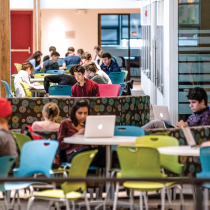 |
 |
||||||||||||||
| Discover Act Create ConnectRemembering Fred Time and the Hour Miracle on College AveA Space for Next-Gen ThinkingCharacter Sketch Great ProfessorNewswireHead of the Class The Big Day Departments |
 |
| Photo: Alonso Nichols |
A Space for Next-Gen Thinking
Collaborative Learning and Innovation Complex seeds tomorrow’s great ideasStanding beside a pristine whiteboard, Usman Khan, an assistant professor of electrical and computer engineering, considers what it symbolizes about his new work environment. Sure, the renovated century-old upholstery factory at 574 Boston Avenue is stunning, a blend of contemporary design and industrial history. But the gleaming whiteboard, he says, invites brainstorming, and that is at the core of the new Collaborative Learning and Innovation Complex, or CLIC, as it’s often called.
“I look forward to filling the white board with symbols, equations, concepts,” says Khan, who is developing the next generation of data-gathering drones. “We need to bounce ideas around, and now we are in a place where that can happen.”
That says a lot about the larger vision for CLIC, the new home for three academic departments: physics and astronomy, occupational therapy, and community health. Also in the new building are the Human-Centered Engineering Laboratory, the Human Factors Engineering Program, the Entrepreneurial Leadership Studies Program, and some faculty from the Eliot-Pearson Department of Child Study and Human Development.
“Departments continue to be critical units for creating and disseminating knowledge and for educating and training students,” says Provost David Harris. “But it is also clear that advances in many areas are more likely to occur when people with a range of perspectives and skills come together.”
‘Like Walking into Google’
The four-story, 95,000-square-foot building on the southern edge of the Medford/Somerville campus has massive wooden beams, wood floors, and generous windows. Tufts and the architectural firm ADD Inc. wanted to preserve the history and yet meet the vastly different needs of 250 full-time faculty and staff. “Because it was a new type of building and a new type of use, we had a lot of ideas about how to do that,” says Barbara Stein, the university’s director of capital programs. “We took our time reexamining how we do things at Tufts.”
The difference is immediately apparent. The large space has been carved into departmental areas that line the perimeter, and smaller “social zones”—public areas with seating arrangements for small and larger groups. The open flow is carried through many design elements, such as the generous use of interior glass and the amped-up fruity colors—orange, lime, and teal. “Students have said to me, ‘Wow, I feel like I’m walking into Google!’ ” says Inga Milde, J95, executive director of Entrepreneurial Leadership Studies.
CLIC is also a model of sustainability and is expected to receive a gold LEED rating, the Leadership in Energy and Environmental Design certification that recognizes green building strategies and practices.
A stand-out public space is the fourth-floor Davenport Family Foundation Gallery, where elevated windows running the full length of the building infuse a twenty-foot-wide corridor with natural light. The gallery offers ample seating areas where both whiteboards and blackboards invite students to tackle homework together.
Specialized spaces include a new classroom for occupational therapy, outfitted with a kitchen and bathroom to give students the hands-on experience they will need to work with clients. And the new Usability Lab for Human-Centered Engineering, a gift of the Cornfeld family, has a one-way mirror for observing how people use prototypes, such as a medical device in a simulated hospital room setting.
The Davenport Family Foundation classroom on the fourth floor, and the Otis-Spiropoulos Family classroom on the third, support diverse teaching styles, says Hugh Gallagher, an associate professor of physics. “I teach introduction to modern physics, and I like to include group work,” he says. “Now I can say, Take your table, roll it to a corner, spread out, and work together.”
Milde has designated one area as the “venture lab,” a place where entrepreneurship students can refine their ideas for startups. She predicts the future of CLIC will parallel the energy that bubbles up in that small room.
“I’ve seen how Tufts students are very comfortable walking across imaginary boundaries and reaching out to different departments,” she says. “I am eager to see that same cross-pollination potential grow here in CLIC. It might start with just the natural happenstance of us being close together. And once that starts, the inspiration will come.”